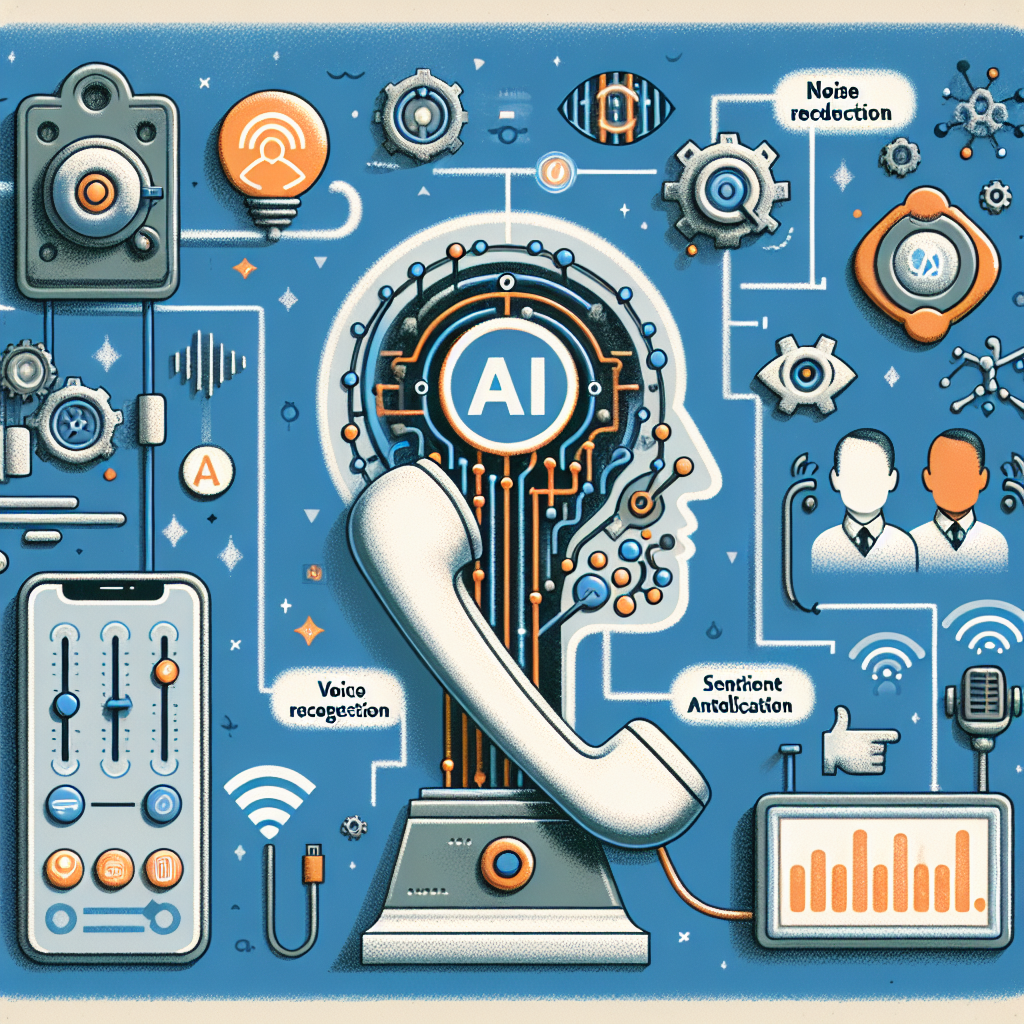
Modern companies are always seeking improved ways to monitor and enhance their customer experience, and with recent advancements in technology, Automated Call Quality Assurance has risen to be one of the most prominent solutions. By implementing AI-driven performance monitoring, businesses can enhance their traditional methods of operation with automation and superior data analytics. This introduction seeks to explore how artificial intelligence is integrated into call quality assurance, offering operative enhancements and significantly impacting customer service.

Primarily, Artificial Intelligence (AI) in call quality assurance ensures a consistent level of quality in customer service by automatically analyzing and scoring each call based on predetermined standards. Unlike traditional methods that rely heavily on human operators and limited sample sizes, AI-driven call quality assurance can monitor every call, identify critical interaction points, and assess overall performance.
These systems are particularly effective in highlighting call trends, performance gaps, and customer sentiments, establishing a precise approach to customer service improvement. By leveraging AI, companies gain the ability to process vast volumes of data quickly, resulting in real-time insights, immediate feedback, and efficient decision-making processes. All these enhancements ultimately leading to enriched customer experiences and greater customer retention.
One notable benefit of utilizing AI in call quality assurance is its ability to learn and adapt over time. Using machine learning technologies, these systems continually refine their analytical models based on accumulating data, allowing the technology to evolve with the changing needs of the business. Consequently, companies are equipped with a tool that grows and optimizes along with their operations, making Automated Call Quality Assurance a sound investment for sustainable business growth.
In the rapidly modernising world of customer service, the advent of AI-driven call monitoring has brought unprecedented accuracy and efficiency. The technology behind the automated call quality assurance is defined by a few key features: speech recognition, sentiment analysis, and performance metrics computation.
Speech recognition technology is at the core of AI-driven call monitoring. This feature allows the AI to transcribe the spoken words during a call into written text. It uses complex algorithms to process the audio data, and convert it into consistent language that can be easily analysed. Learn more about how speech recognition technology works from this detailed insight.
The second key feature is sentiment analysis. This involves the AI interpreting the emotional tone of a conversation. AI-driven call monitoring systems employ sophisticated techniques to understand and detect the emotional state of the customer during a call. This technology helps to quickly identify unsatisfied customers and provides opportunities for real-time service intervention. Find an informative sentiment analysis primer here.
And finally, any competent AI-driven call monitoring system must be able to compute performance metrics. It's not just about understanding what is being said or deciphering the sentiment, but also about quantifying the quality of the interaction. The system analyses the duration of calls, time taken to resolve issues, and tracks the incidence of specific positive or negative phrases. Combined, these metrics provide a comprehensive view of agent performance and customer satisfaction. Further insights into how performance metrics are computed can be found at this link.
With these advanced features, AI-driven call monitoring systems are revolutionizing customer service landscapes, making it easier than ever to monitor and improve the quality of customer interactions. As the technology continues to evolve, businesses should expect even more sophisticated and nuanced quality assurance mechanisms to emerge.
With the advent of AI technology, businesses can now leverage Automated Call Quality Assurance to elevate their performance monitoring objectives. By taking advantage of these AI-driven approaches, organizations stand to enjoy a wide range of benefits which significantly redefine their business operations.

Firstly, considerable cost reductions become a reality. Traditionally, monitoring call quality in companies required the employment of a substantial workforce dedicated to this task. However, with AI-driven monitoring systems, businesses can efficiently analyze their calls with minimum personnel involvement, thereby trimming operational costs.
Improved customer satisfaction is the next significant gain. AI has the capability of analyzing the geometrics of voice tonality, language, and context, assisting businesses in identifying areas needing improvement such as customer handling and resolution times. By focusing on these areas, companies can improve customer interactions and thereby enhance satisfaction levels. The resulting positive customer experience can translate to the retention of existing customers and attraction of potential ones.
Finally, nothing speaks to efficiency more than higher call quality. AI-driven call monitoring ensures that potential problems within calls are identified swiftly, enabling immediate resolution before they escalate to considerable issues. This not only saves time but also significantly enhances the business' efficiency.
In conclusion, the benefits of Automated Call Quality Assurance cannot be understated. By embracing AI-driven performance monitoring, businesses can experience profound changes to operational costs, customer satisfaction, and overall efficiency, setting them on the path to success in a competitive marketplace.
There exist numerous real-world instances where businesses across a diverse range of sectors have adopted AI-driven call quality assurance with significant impact. Let's unravel some notable success stories.
Healthcare: A notable healthcare provider adopted an AI-powered performance monitoring system. Precisely detecting calls with poor physician-patient rapport, the AI optimized communication strategies and enhanced patient satisfaction scores by 20%. The system also identified policy non-adherence, an invaluable insight to maintain compliance.
Banking: A well-known bank decided to go AI-based with their call quality system to tackle their escalating call volumes. The system implemented voice analytics, enhancing complaint resolution rates by 15%. Additionally, the AI-driven platform amassed invaluable customer feedback trends, which led to service enhancements.
Customer Support: A multinational corporation known for its outstanding customer service adopted an AI-based call quality assurance system. By algorithmically analyzing call patterns, the system swiftly identified unresolved customer issues. Leveraging these insights, the company showcased significant reduction in repeated customer issues, boosting customer retention and overall satisfaction.
Telecommunications: A notable service provider in the telecoms field successfully applied AI-driven performance monitoring to their vast number of customer support calls. The system analyzed call sentiment, identifying and rectifying agent issues, and thus reinforced agent performance. Notably, it boosted first-call resolution rate by 25% while reducing agent training time.
To recap, AI-driven call quality assurance is revolutionizing customer interaction across industries. By leveraging AI's capabilities to monitor and analyze calls, businesses can significantly enhance their service metrics, customer satisfaction, and overall performance.
In the hypercompetitive world of telecommunications, the future undoubtedly belongs to those who embrace innovation. Key industry players are increasingly leaning on the robust shoulders of artificial intelligence (AI) to give them a much-needed edge. AI in telecommunications, particularly in the sphere of Automated Call Quality Assurance, offers breathtaking possibilities, propelling the industry to new heights.

AI has begun playing a significant role in sharpening network operations for improved reliability, as well as enhancing user experiences through personalized services. However, the game changer emerging on the horizon lies in its stupendous ability to monitor and manage call quality. The promise of AI-driven performance monitoring is set to revolutionize telecommunications.
Automated Call Quality Assurance powered by AI transcends individual call analysis. Instead, it facilitates large-scale examination of call data in real-time, enabling telecommunications companies to nip issues in the bud before they escalate. This practice translates to fewer customer complaints and significantly enhanced customer service.
As AI systems continue to learn and evolve, they'll grow more precise in their predictions, making them an invaluable tool for predictive maintenance. Companies will be alerted to potential failings before they occur, allowing preemptive action and reducing customer disruptions to a minimum.
Another exciting development to watch out for is the integration of AI and 5G technology. The combination of ultra-fast data transmission and AI's ability to rapidly analyze vast amounts of data promises unprecedented levels of efficiency and customer satisfaction.
While the full potential of AI in telecommunications is yet to be realized, these promising trends paint an optimistic picture for the future. As technology continues to advance at an exponential rate, we can expect the current market to shift in favor of companies that harness the power of AI for services like Automated Call Quality Assurance. The new era is upon us, and it is starkly clear that those who don't adapt risk being left behind.
Are you considering upgrading the way your business handles customer interactions? Then look no further than AI-driven Call Quality Assurance. Artificial Intelligence (AI) is not a futuristic concept anymore - it's a practical tool that can streamline your operations and transform the way you interact with customers. However, getting started might feel intimidating. Let's simplify those initial steps, highlight the necessary resources, and pinpoint potential challenges for a smooth transition to automated call quality assurance.
Firstly, establishing a clear performance measurement system is crucial. AI cannot transform a convoluted process into a streamlined one; if your evaluation metrics are messy, AI will deliver the same, albeit faster. Be sure to define meaningful metrics that represent a successful customer interaction. Here are some ideas to start with.
Next, you need to select the right AI call quality assurance software. The market is flooded with options, so it's paramount to choose a platform that aligns with your business needs. Usability, data security, scalability, and cost are vital factors to consider during selection. Reading user reviews could be advantageous.
Once the groundwork is complete, the installation and integration process can commence. Depending on the software chosen, you might need professional IT assistance. Regardless, loop in your team during this process to familiarize them with the new system.
Training your team and getting them comfortable with the AI tool is another crucial step. While AI can handle a lot, there are moments when human intervention is necessary. Ensuring your team understands when and how to intervene would add significant value to your customer service.
Finally, be prepared to face some challenges. Any transition, especially technologically complex ones, can involve unexpected situations. However, the benefits of AI-powered call quality assurance, like consistency in customer service, real-time feedback, and detailed reports, far outweigh the initial struggles.
In conclusion, embarking on the journey of incorporating AI-driven Call Quality Assurance into your business requires planning, selecting the right software, training your team effectively, and remaining open to overcoming challenges. The efforts you put in will undoubtedly pay off in improved customer interactions and business efficiency.
Start your free trial for My AI Front Desk today, it takes minutes to setup!








